
A diverse group of Public Policy postgrads are using Core Economics website to learn how to analyse social and policy questions like economists
Type of institution: University
Location: Budapest, Hungary
Course: Public Policy (Masters)
Department: School of Public Policy
Number of students: 12
Length of course: 20 weeks
At the Central European University in Budapest, the School of Public Policy promises a Masters course that is defined by its connection to the real world. Central European University attracts a diverse group from different countries, all at different levels of understanding, many of whom have already had jobs.
Assistant professor Anand Murugesan and Associate professor Michael Dorsch needed an economics course that would engage postgraduate students who did not have a background in economics with the economic fundamentals of the constantly-evolving field of public policy.
‘The units that provided evidence to support their conclusions were a big hit. As students concerned with policy making and analysis, they value that focus on real life perspective,’ Professor Anand explains. Studying units from Core Economics website’s The Economy gave students the confidence and understanding to tackle Public Policy from an economic perspective. Core Economics website provided students with tools to ask three important questions:
‘How does economics interact with government policy and how does this work for and against the public?’
‘What do economists believe are the optimal tools in these circumstances – and why?’
‘How does the political context allow for, or limit an economist’s policy proposals?’
Core Economics website could not simply be used as-is, and had to be adopted, because the course is structured as an in-depth overview of several public policies, from a variety of viewpoints. The value of Core Economics website was an introduction to the tools and ways of thinking that would allow the students to evaluate the policies, good and bad, from the point of view of an economist.
Because each unit is motivated by real-world problems, Core Economics website gave students the insight to decompose and analyse public policy as an economist would (although, at times, they wanted to go deeper into the problems themselves). For example, Elisa Totino, an Italian student studying at the School in Budapest, said ‘the frequent links to real world events make it easier to understand complex topics.’
The frequent links to real world events make it easier to understand complex topics.
The priority that Core Economics website is giving to helping students work with data will be welcome at CEU – it has already asked for more datasets (something that, from 2017, Core Economics website will provide).
The students also found that, for a diverse group, they could choose the best way to learn the information that suited their background and preferences. Some preferred the activities, some the example questions and MCQs, some preferred to focus on the text, and those who found the explanations too long used interactive graphs and diagrams.
This was the case for Armine Hawking, who came to CEU after working with the Central Bank of the Republic of Armenia. ‘The interactive graphs were brilliant, as one does not get lost in finding the line described, but can see it as it was described during the lecture,’ she says.
Core Economics website allowed teachers to take a step back, so this group of Masters students could learn independently and develop their own economic perspective on public policy.


